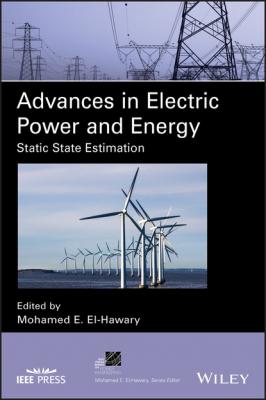Advances in Electric Power and Energy. Группа авторов
Читать онлайн.| Название | Advances in Electric Power and Energy |
|---|---|
| Автор произведения | Группа авторов |
| Жанр | Физика |
| Серия | |
| Издательство | Физика |
| Год выпуска | 0 |
| isbn | 9781119480440 |
Figure 2.13 Histogram of voltage magnitude estimation accuracy for each method.
Figure 2.14 Histogram of voltage angle estimation accuracy for each method.
Figure 2.15 Histogram of the computation time for each estimator.
In Tables 2.14 and 2.15 and Figures 2.13–2.15, we can observe the following:
1 In terms of estimation accuracy, the WLS, QC, QL, and LMR procedures are more precise than the other procedures in estimating both voltage magnitudes and angles. On the other hand, the accuracy provided by the LMS algorithm is worse than that provided by other estimators.Note that the absolute errors are notably small for all the estimators, with the exception of the LMS and LTS approaches, whose absolute errors are five and three times higher than those of other procedures.Note also that the accuracy variability of the LMS estimator is high for both the magnitude and the angle estimates.
2 From the computational point of view, the LAV and QC approaches are more efficient than the other procedures. Observe that these two techniques slightly outperform the conventional WLS method. However, the LMS and LTS methods require a larger amount of CPU time, owing to the non‐convexities of their mathematical programming formulations and the non‐differentiable objective functions.
In Figure 2.15, note that the variability of the computation time required for the LMR procedure is significantly high, but its average value coincides with that of the LMS technique.
2.5.11.1 Performance Analysis: Bad Data
All estimators presented in this chapter (with the exception of the WLS) are robust when dealing with bad data, i.e. a gross error does not significantly influence the estimated state.
If WLS estimator is used, then bad measurement detection and identification procedures must be employed after the estimation process in order to eliminate any bad data that may populate the measurement set. These detection and identification procedures are generally based on χ2 test and on normalized residuals, respectively (see [18]).
According to the traditional bad measurement detection procedure, if the objective function value at the estimated state
Therefore, if a bad measurement is corrupting the measurement set but its magnitude is not sufficiently large to satisfy
In the study below, two bad measurements are present in each measurement scenario. The magnitude of the corresponding error is sufficiently small to satisfy the condition
One hundred measurement scenarios have been considered, and Tables 2.16 and 2.17 provide the results concerning estimation accuracy and computational performance, respectively. Note that the format of these tables is similar to that of Tables 2.14 and 2.15.
TABLE 2.16 Case study: estimation accuracy results with bad measurements.
| Method |
|
|
|
|
|---|---|---|---|---|
| WLS | 0.0019 | 0.0014 | 0.0017 | 0.0014 |
| LAV | 0.0019 | 0.0016 | 0.0019 | 0.0016 |
| QC | 0.0016 | 0.0012 | 0.0017 | 0.0014 |
| QL | 0.0016 | 0.0012 | 0.0017 | 0.0014 |
| LMS | 0.0103 | 0.0106 | 0.0053 | 0.0047 |
| LTS | 0.0050 | 0.0048 |
|
